
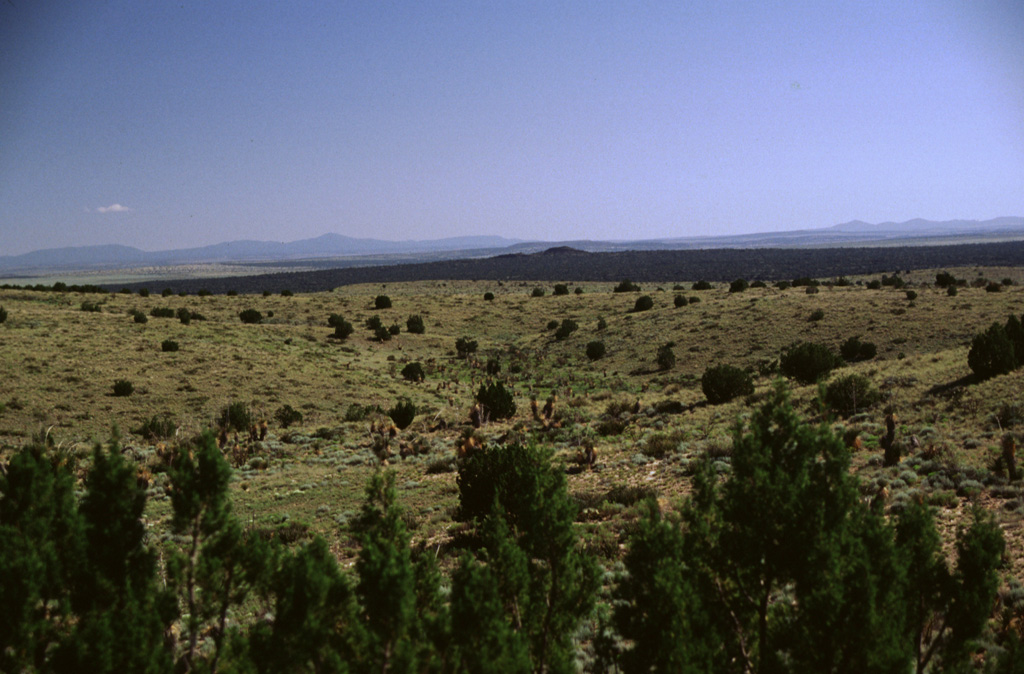
The Global Volcanism Program has no activity reports available for Carrizozo.
The Global Volcanism Program has no Weekly Reports available for Carrizozo.
The Global Volcanism Program has no Bulletin Reports available for Carrizozo.
|
|
||||||||||||||||||||||||||
There is data available for 1 confirmed eruptive period.
3250 BCE ± 500 years Confirmed Eruption (Explosive / Effusive)
| Episode 1 | Eruption (Explosive / Effusive) | Little Black Peak | ||||||||||||||||||||||||||||
|---|---|---|---|---|---|---|---|---|---|---|---|---|---|---|---|---|---|---|---|---|---|---|---|---|---|---|---|---|---|
| 3250 BCE ± 500 years - Unknown | Evidence from Isotopic: Cosmic Ray Exposure | ||||||||||||||||||||||||||||
|
List of 4 Events for Episode 1 at Little Black Peak
|
|||||||||||||||||||||||||||||
This compilation of synonyms and subsidiary features may not be comprehensive. Features are organized into four major categories: Cones, Craters, Domes, and Thermal Features. Synonyms of features appear indented below the primary name. In some cases additional feature type, elevation, or location details are provided.
Synonyms |
||||
| Malpais, The | ||||
Cones |
||||
| Feature Name | Feature Type | Elevation | Latitude | Longitude |
| Little Black Peak | Cone | 1731 m | 33° 47' 0.00" N | 105° 56' 0.00" W |
Craters |
||||
| Feature Name | Feature Type | Elevation | Latitude | Longitude |
| Broken Back | Crater | |||
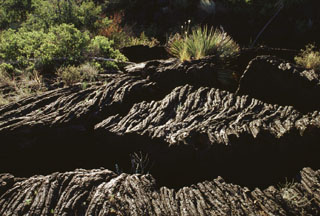 Fractures cut the surface of a roughly 5000-year-old ropy pahoehoe lava flow in south-central New Mexico. Lava flow textures such as these are formed when molten lava continues to flow underneath the cooled plastic skin, causing the surface to bunch up or wrinkle into a form that resembles coiled rope. Highway 380 cuts across the northern part of the Carrizozo lava flow, providing access to the flow.
Fractures cut the surface of a roughly 5000-year-old ropy pahoehoe lava flow in south-central New Mexico. Lava flow textures such as these are formed when molten lava continues to flow underneath the cooled plastic skin, causing the surface to bunch up or wrinkle into a form that resembles coiled rope. Highway 380 cuts across the northern part of the Carrizozo lava flow, providing access to the flow. 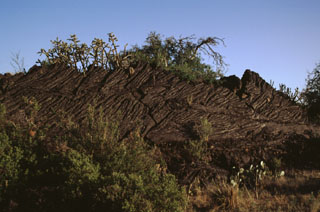 Slabs of basaltic pahoehoe lava are tilted along a pressure ridge of the Carrizozo lava flow in New Mexico. This massive tube-fed pahoehoe flow displays abundant evidence of inflation features such as tumuli, pressure ridges, and lava pits. Tumuli form when brittle crust buckles to accommodate the inflating core of the flow, thus creating a central crack along the length of the tumulus. These structures sometimes grade into elongated features called pressure ridges.
Slabs of basaltic pahoehoe lava are tilted along a pressure ridge of the Carrizozo lava flow in New Mexico. This massive tube-fed pahoehoe flow displays abundant evidence of inflation features such as tumuli, pressure ridges, and lava pits. Tumuli form when brittle crust buckles to accommodate the inflating core of the flow, thus creating a central crack along the length of the tumulus. These structures sometimes grade into elongated features called pressure ridges.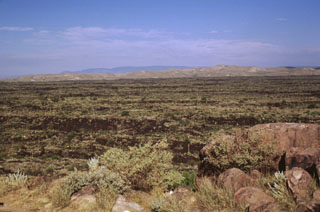 The sparsely vegetated lava flow filling a broad valley is the Carrizozo lava flow, which was erupted from a low shield volcano topped by the Little Black Peak cinder cone. The massive lava flow, which was dated at about 5200 years Before Present, traveled 75 km down the Tularosa Basin in south-central New Mexico. The extremely lengthy travel distance of the flow (one of the longest on Earth during Holocene time) was facilitated by movement within lava tubes, which thermally insulated the flow.
The sparsely vegetated lava flow filling a broad valley is the Carrizozo lava flow, which was erupted from a low shield volcano topped by the Little Black Peak cinder cone. The massive lava flow, which was dated at about 5200 years Before Present, traveled 75 km down the Tularosa Basin in south-central New Mexico. The extremely lengthy travel distance of the flow (one of the longest on Earth during Holocene time) was facilitated by movement within lava tubes, which thermally insulated the flow. 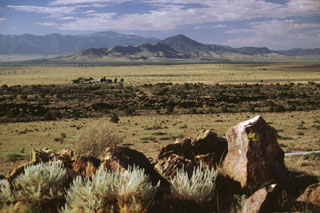 The dark-colored lava flow extending across the center of the photo is a lobe of the Carrizozo flow. This view looks SE from the Valley of Fires recreation area administered by the Bureau of Land Management to the Sierra Blanca in the distance. The recreation area lies on one of several kipukas of older rocks surrounded by the Carrizozo flow, which covers an area of about 330 km2.
The dark-colored lava flow extending across the center of the photo is a lobe of the Carrizozo flow. This view looks SE from the Valley of Fires recreation area administered by the Bureau of Land Management to the Sierra Blanca in the distance. The recreation area lies on one of several kipukas of older rocks surrounded by the Carrizozo flow, which covers an area of about 330 km2. The small dark hill in the middle distance right of center is Little Black Peak, a cinder cone topping a broad low shield volcano that was the source of the massive Carrizozo lava flow, which forms the dark streak extending across the photo. Most of the ~4.2 cu km pahoehoe flow extended off the photo to the right down the low-angle gradient of the Tularosa Basin to the SE for a distance of 75 km.
The small dark hill in the middle distance right of center is Little Black Peak, a cinder cone topping a broad low shield volcano that was the source of the massive Carrizozo lava flow, which forms the dark streak extending across the photo. Most of the ~4.2 cu km pahoehoe flow extended off the photo to the right down the low-angle gradient of the Tularosa Basin to the SE for a distance of 75 km. 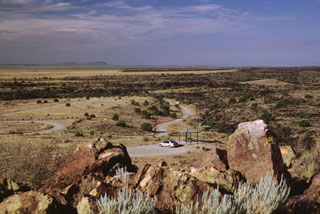 The Carrizozo lava flow surrounds the southern end of a kipuka providing a campground site in the Valley of Fires Recreation Area. This massive tube-fed pahoehoe lava flow, with a volume of about 4.3 cubic km, traveled 75 km down the extremely low-angle floor of the Tularosa Basin, with slopes of less than half a degree. The flow was inferred to have been emplaced during low-effusion-rate, long-duration eruption lasting 2-3 decades.
The Carrizozo lava flow surrounds the southern end of a kipuka providing a campground site in the Valley of Fires Recreation Area. This massive tube-fed pahoehoe lava flow, with a volume of about 4.3 cubic km, traveled 75 km down the extremely low-angle floor of the Tularosa Basin, with slopes of less than half a degree. The flow was inferred to have been emplaced during low-effusion-rate, long-duration eruption lasting 2-3 decades.The following 1 samples associated with this volcano can be found in the Smithsonian's NMNH Department of Mineral Sciences collections, and may be availble for research (contact the Rock and Ore Collections Manager). Catalog number links will open a window with more information.
| Catalog Number | Sample Description | Lava Source | Collection Date |
|---|---|---|---|
| NMNH 117124 | Basalt | -- | 1 Jul 1999 |
| Copernicus Browser | The Copernicus Browser replaced the Sentinel Hub Playground browser in 2023, to provide access to Earth observation archives from the Copernicus Data Space Ecosystem, the main distribution platform for data from the EU Copernicus missions. |
| MIROVA | Middle InfraRed Observation of Volcanic Activity (MIROVA) is a near real time volcanic hot-spot detection system based on the analysis of MODIS (Moderate Resolution Imaging Spectroradiometer) data. In particular, MIROVA uses the Middle InfraRed Radiation (MIR), measured over target volcanoes, in order to detect, locate and measure the heat radiation sourced from volcanic activity. |
| MODVOLC Thermal Alerts | Using infrared satellite Moderate Resolution Imaging Spectroradiometer (MODIS) data, scientists at the Hawai'i Institute of Geophysics and Planetology, University of Hawai'i, developed an automated system called MODVOLC to map thermal hot-spots in near real time. For each MODIS image, the algorithm automatically scans each 1 km pixel within it to check for high-temperature hot-spots. When one is found the date, time, location, and intensity are recorded. MODIS looks at every square km of the Earth every 48 hours, once during the day and once during the night, and the presence of two MODIS sensors in space allows at least four hot-spot observations every two days. Each day updated global maps are compiled to display the locations of all hot spots detected in the previous 24 hours. There is a drop-down list with volcano names which allow users to 'zoom-in' and examine the distribution of hot-spots at a variety of spatial scales. |
|
WOVOdat
Single Volcano View Temporal Evolution of Unrest Side by Side Volcanoes |
WOVOdat is a database of volcanic unrest; instrumentally and visually recorded changes in seismicity, ground deformation, gas emission, and other parameters from their normal baselines. It is sponsored by the World Organization of Volcano Observatories (WOVO) and presently hosted at the Earth Observatory of Singapore.
GVMID Data on Volcano Monitoring Infrastructure The Global Volcano Monitoring Infrastructure Database GVMID, is aimed at documenting and improving capabilities of volcano monitoring from the ground and space. GVMID should provide a snapshot and baseline view of the techniques and instrumentation that are in place at various volcanoes, which can be use by volcano observatories as reference to setup new monitoring system or improving networks at a specific volcano. These data will allow identification of what monitoring gaps exist, which can be then targeted by remote sensing infrastructure and future instrument deployments. |
| Volcanic Hazard Maps | The IAVCEI Commission on Volcanic Hazards and Risk has a Volcanic Hazard Maps database designed to serve as a resource for hazard mappers (or other interested parties) to explore how common issues in hazard map development have been addressed at different volcanoes, in different countries, for different hazards, and for different intended audiences. In addition to the comprehensive, searchable Volcanic Hazard Maps Database, this website contains information about diversity of volcanic hazard maps, illustrated using examples from the database. This site is for educational purposes related to volcanic hazard maps. Hazard maps found on this website should not be used for emergency purposes. For the most recent, official hazard map for a particular volcano, please seek out the proper institutional authorities on the matter. |
| IRIS seismic stations/networks | Incorporated Research Institutions for Seismology (IRIS) Data Services map showing the location of seismic stations from all available networks (permanent or temporary) within a radius of 0.18° (about 20 km at mid-latitudes) from the given location of Carrizozo. Users can customize a variety of filters and options in the left panel. Note that if there are no stations are known the map will default to show the entire world with a "No data matched request" error notice. |
| UNAVCO GPS/GNSS stations | Geodetic Data Services map from UNAVCO showing the location of GPS/GNSS stations from all available networks (permanent or temporary) within a radius of 20 km from the given location of Carrizozo. Users can customize the data search based on station or network names, location, and time window. Requires Adobe Flash Player. |
| DECADE Data | The DECADE portal, still in the developmental stage, serves as an example of the proposed interoperability between The Smithsonian Institution's Global Volcanism Program, the Mapping Gas Emissions (MaGa) Database, and the EarthChem Geochemical Portal. The Deep Earth Carbon Degassing (DECADE) initiative seeks to use new and established technologies to determine accurate global fluxes of volcanic CO2 to the atmosphere, but installing CO2 monitoring networks on 20 of the world's 150 most actively degassing volcanoes. The group uses related laboratory-based studies (direct gas sampling and analysis, melt inclusions) to provide new data for direct degassing of deep earth carbon to the atmosphere. |
| Large Eruptions of Carrizozo | Information about large Quaternary eruptions (VEI >= 4) is cataloged in the Large Magnitude Explosive Volcanic Eruptions (LaMEVE) database of the Volcano Global Risk Identification and Analysis Project (VOGRIPA). |
| EarthChem | EarthChem develops and maintains databases, software, and services that support the preservation, discovery, access and analysis of geochemical data, and facilitate their integration with the broad array of other available earth science parameters. EarthChem is operated by a joint team of disciplinary scientists, data scientists, data managers and information technology developers who are part of the NSF-funded data facility Integrated Earth Data Applications (IEDA). IEDA is a collaborative effort of EarthChem and the Marine Geoscience Data System (MGDS). |